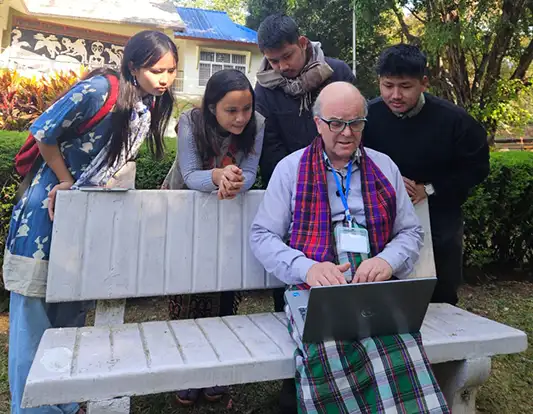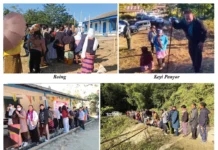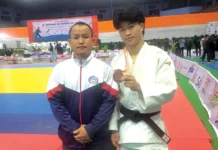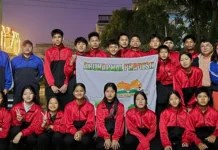[Apasi Linggi, Kara Gambo, Tenjing Koyu & Indu Chukhu]
Rono Hills, 21 Jan: Dr Stephan Morey from La Trobe University has done extensive research on smaller often endangered languages, spoken on the India-Myanmar border covering four language groups: Tai, Singpho, Tangsa and Wancho. He also researches the Aboriginal languages of Victoria. The Arunachal Times met Dr Morey at the Arunachal Institute of Tribal Studies, Rajiv Gandhi University, Rono Hills.
Ethical dilemmas in tribal language documentation
In his extensive fieldwork with the Tangsa community and others in Arunachal Pradesh, Thailand, and Myanmar, Dr Stephen Morey has faced critical ethical challenges concerning intellectual property rights, informed consent, and the potential commodification of indigenous knowledge. He highlighted the difficulty of explaining the full implications of recordings to elderly participants. “Many people are happy to have their knowledge preserved for their children and grandchildren, even those they may never meet,” he said.
Dr Morey has prioritised ensuring that these recordings are accessible to the communities. He emphasised the importance of archiving materials securely to prevent loss or damage, making them available for future generations. “If a pen drive is lost or damaged, the archive ensures that the recordings are still safe,” he noted.
Ownership of the recordings is a crucial question. Dr Morey challenged the notion that the person making the recording owns the material. “This is crazy because pressing the record button doesn’t mean the knowledge belongs to me – it belongs to the storyteller or the singer,” he argued.
One of Dr Morey’s significant experiences involved borrowing tapes from the niece of Professor Dr Khun Banchob Bandhumedha, who recorded Tai languages in the 1950s and the 1960s. After digitising these recordings, he returned them to the communities. In one instance, a young man heard his father’s voice for the first time. “The father had passed away when the boy was one year old. Hearing his father singing was a special, irreplaceable moment,” he recalled.
Dr Morey acknowledged that commodification of traditional recordings is a concern, but in his experience, people have valued the recordings for their cultural significance rather than for commercial purposes.
Frameworks to ensure community interest
Dr Morey admitted that academic research, such as grammar studies and linguistic documentation, often serves a broader audience rather than providing immediate benefits to the communities involved. However, he emphasised the importance of returning something meaningful to these communities.
He shared examples of working collaboratively with people to produce dictionaries, develop scripts, and create orthographies. These contributions empower communities to preserve and document their languages themselves. “The research I’ve done earlier allows me to help in creating these tools,” he explained.
Dr Morey also highlighted the difficulty of maintaining long-term connections with communities due to the nature of his work. He recalled visiting Borkhamti village in 2005 and only now, nearly two decades later, revisiting to share recordings with the people. “Sometimes it takes years to return, but when I do, I try to contribute meaningfully,” he said.
By collaborating with various groups, such as the Lepcha speakers in Sikkim, Dr Morey has applied his knowledge to assist communities in developing writing systems and scripts, often using his prior research as a foundation.
Challenges in digital documentation
Dr Morey described the challenges of digitally recording traditional songs, stories, and languages, noting that the process involves much more than simply pressing the record button. While modern tools have made recording easier, the real difficulties lie in managing the recordings afterward.
“You can’t just record and leave it at that. Six months later, you won’t remember what it is,” he explained. Proper documentation requires creating detailed metadata, including the names of speakers, dates, locations, and descriptions of the content. “The more information you can include, the better,” he said.
Transcription is another labour-intensive aspect, especially for languages without established writing systems. For example, he said, when dealing with tonal languages like Tai, where subtle differences in pronunciation can entirely change meanings, like “In Tai Phake, a single word like ‘na’ can carry six completely distinct meanings depending on the tone. For example ; Nà (low tone): ‘Face’, Nã (high tone): ‘Your mother’s sister’, Nã (rising tone): ‘Melting away’, Na (level tone): ‘Thick’, Na (level tone): ‘Tart’, Nã (nasal tone): ‘Paddy field’.
“Without a standardised system to mark tones, how do we accurately represent these differences? This is one of the complexities involved in documenting tonal languages like Tai Phake,” he said. “It requires careful consideration of how these sounds should be represented in writing.”
Dr Morey highlighted the complexities of recording unwritten languages, such as those in Arunachal, where scripts may not be standardised or familiar to speakers. Additionally, some languages, like Bodo, have transitioned between multiple writing systems over time, further complicating documentation efforts.
He also mentioned receiving messages from the Lungchang group of the Tangsa community, requesting advice on the best way to write their language. “This is not a small question – it requires significant time and expertise,” he said.
Furthermore, the issue of cross-border communication between communities in India and Myanmar also adds complexity to the documentation process. As Dr Morey shared, some communities, like the Tangsa, are split between the two countries. This division hampers their ability to maintain contact, although digital tools like Facebook and WhatsApp have helped bridge this gap in recent years.
Despite these challenges, Dr Morey continues to refine his methods, ensuring that each recording is not only preserved but also well-documented for future use.
Exploring the intersection of linguistic documentation and cultural identity
Dr Morey shared his insights into the challenges and opportunities surrounding tribal languages, particularly in the context of Arunachal.
During the interview, Morey highlighted the pressing need for documentation and community engagement to preserve and promote linguistic heritage.
The influence of documentation on cultural identity
When asked about the impact of documenting and analysing tribal languages on community perceptions of their linguistic and cultural identity, Dr Moray admitted that he hadn’t observed direct shifts in such perceptions. However, he noted the commendable efforts of individuals from Northeast India who are studying and documenting their native languages, leveraging their intimate knowledge of the linguistic nuances.
Dr Morey also pointed out that historical documents, particularly British colonial records referencing tribal communities, hold the potential to spark discussions about cultural and linguistic heritage. This interest in historical context could serve as a stepping stone for revitalising pride and curiosity about indigenous languages.
Challenges and hopes for endangered languages
On the topic of younger generations losing touch with their native languages, Dr Morey expressed concern over the endangerment of these languages. He emphasised the importance of investing resources in linguistic documentation, such as sending researchers to villages to study grammatical structures.
Interestingly, he observed that individuals above the age of 30 often show renewed interest in their linguistic heritage by learning traditional songs and stories. Dr Morey stressed the importance of leveraging modern technology to record these oral traditions, ensuring they are preserved for future generations.
Dr Morey’s message to Arunachali communities in safeguarding the Arunachali languages was simple yet profound: “Speak your language, sing in your language, and tell stories in your language.”
He urged people to take time from their daily lives, even if influenced by Hindi, English, or other dominant languages, to converse in their native tongue with their children.
Reflecting on his own experience growing up in Australia, where linguistic diversity is rare, he expressed admiration for the rich cultural and linguistic diversity of Arunachal. He encouraged families to foster language use at home, emphasising that this simple act could make a significant difference in preserving their unique heritage.
Dr Stephen Morey’s insights underline the urgent need for both grassroots and institutional efforts to preserve endangered languages. His emphasis on storytelling, singing, and modern documentation serves as a rallying cry for Arunachali communities to take pride in their linguistic heritage and ensure its survival for generations to come. ( This is the concluding part of interview with linguist Dr Morey. You can access the first part of the interview here…)




